How -to Stop, Thief!
There’s No Guarantee That Your Vehicle Won’t Be Stolen. But Taking These Steps Will Improve Your Odds.
A FEW YEARS ago my son and I were talking to a friend who was the proud owner of a late-model Porsche. At that time, my son was working his way through college repossessing cars. It was a dangerous game, but it was honorable, he loved it, and he could make $800 a night just by bagging two vehicles. The fellow with the Porsche smugly stated that my son would not be able to take his car, thanks to all the wondrous theft prevention technology built into it.
The fellow had his back to the car while we chatted, so with a big grin on his face my son slipped around behind him and over to the car. He quickly slim jimmed the door and had the Porsche started in no time. As my friend spun around, incredulous at what had happened, the lad took the car for a quick spin around the block while I had a good laugh at my friend’s expense.
I tell this story to illustrate that a pro can and will take your car if he wants it badly enough. But most car thieves aren’t pros. In fact, most of them aren’t very smart. They seldom understand much about how cars work, and generally confine themselves to smash and run tactics.
Often as not, they only want the radio or the wheels off of it anyway. Or they may just want a way to get to their girlfriend’s house but don’t have cab fare.
Unfortunately,such thieves are too seldom caught, and generally are barely inconvenienced if they are apprehended.
It’s true that you can’t stop all the thieves all of the time, but you can stop most of them most of the time, and you can make stealing your classic a very difficult proposition. Here are some tips and tricks that I have picked up over the years that have worked well for me:
A Simple Wire Switcheroo
One of the easiest theft prevention tricks is to simply open the hood and switch the coil high-tension wire with one of the spark plug wires on the distributor (Illustration 1).
The car will pop and bang, but it won’t start. Most thieves would never take the time to spot what you have done, and will be frightened off by the unexpected noise and lack of mobility.
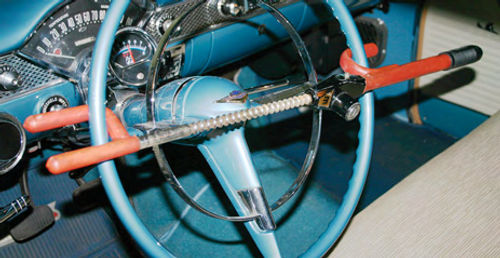
Just remember to switch the wires back before attempting to start the car yourself, lest you treat your neighbors to a cacophony of misfires. Perhaps the best thing about this little trick is it’s free.
Join The Club
One of the least-expensive and most common theft prevention devices is the locking Club (Photo 1). While strapped across your steering wheel, it makes your car impossible to drive for any distance. It also has the advantage of being quite visible to a thief, which can act as a deterrent all by itself. Most thieves are looking for easy prey.
The Club can be defeated, but few thieves know how, and most won’t even try. My son tells me that The Club can be removed using a pipe cutter because the telescoping part of it is hollow, but most people don’t know that. Clubs are available at most auto parts or hardware stores for around $20 (theclub.com).
Theft-Resistant Battery Terminal
One easy-to-install theft prevention device is the two piece battery terminal (Illustration 2). The part of the terminal that grips the battery post is insulated by a thick sheet of plastic from the part that goes to the cable. Connecting them together so you can start the car is a large removable knob that you take out and pop into your pocket when you leave the vehicle. However, these devices are pretty easy to defeat if a thief takes the time to look under the hood and carries his own knob or can scrounge up a similar-size bolt.
Two-piece battery terminals do make disconnecting your battery a breeze, though, and that’s great when you want to work on the car, or want to store it for a prolonged period because it prevents such things as electric clocks from running the battery down.
To install the two-piece terminal you will need to remove the existing terminal from the cable and strip a bit of the wire. You then attach the two-piece terminal and tighten or crimp it into place, depending on its design.
One possible problem is that these two-piece terminals don’t look right on a faithfully restored show car.
Two-piece terminals can be found at auto parts stores and auto swap meets for as little as $5.
Beware the Onboard Computer: One caveat concerning disconnecting the battery on contemporary cars is that it will mess up all of your radio, clock and accessory settings, and may cause problems with the on-board computer as well because it will put it back to its default settings from the factory. The tips offered here are intended for people who want to protect cars made in the precomputer days, not for what I consider to be “modern” cars that are already better-protected from theft than the classics ever were.

Fuel Line Shutoff Switch
It’s a little work to install one, but a fuel shutoff switch is a great way to thwart thieves (Illustration 3).
You mount it at the back of the car, inside the frame, near the gas tank where it can’t be seen except when the car is on a lift.

If you are restoring a car and replacing the fuel lines anyway, you just cut the line, add a couple of flared nipples and hook it up. Someone trying to steal your car might get it started if it has not been sitting long, but they won’t get more than a few feet before any fuel still in the carburetor is depleted.
It’s somewhat of a pain to reach under and turn the lever, but no one is ever going to spot the valve. Such valves also are good for fire prevention when you’re working in the engine compartment. Once again, it’s time for a caveat: Don’t Forget that you have closed the valve, because it’s not good for the old diaphragm-type fuel pumps to pump air for any length of time.
Larger auto parts stores carry these shut-off valves, as do Home Depot and other do-it-yourself outlets. Just make sure you get the right size for your fuel lines and use the correct types of nipples.
Battery Cutoff Switch
By now you may have noticed that all of these suggestions have to do with depriving the engine of either ignition or fuel. And that’s because—obviously— you need gas and spark to start a car. Cut off either one and the car becomes a very large paperweight.
Similar to the fuel line shutoff switch is the battery cutoff switch (Illustration 4 and Photo 2). A typical one for a 12-volt battery system costs as little as $5. You will need a much bigger switch for a 6- volt system because 6-volt systems produce twice the amps. A 12-volt switch will burn out in short order when installed in a 6-volt electrical system.
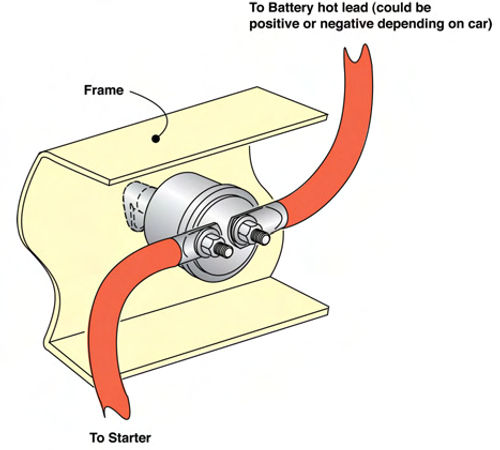
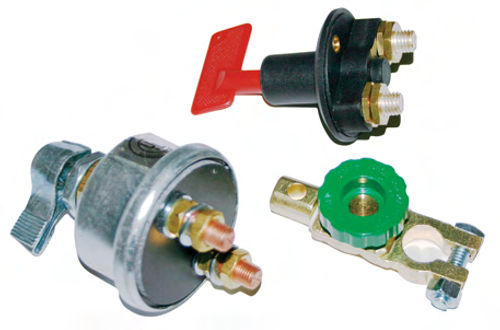
The switch can be installed in either the positive or negative battery cable depending on your make and year. (Many Earlier cars used six-volt batteries and positive ground. Negative ground is standard today.)
To install a cutoff switch you simply run—for example—the positive battery cable to the switch, and then get another cable with screw terminals on both ends to go from the switch to the starter. Mount the switch where it is not obvious, such as on the frame underneath, and coat its terminals with white grease to protect them from corrosion.
Some battery cutoffs come with a removable key, which would make a thief’s job a little harder, assuming he discovers your cutoff switch in the first place. But other switches have an on-off lever built in. In that case, concealment is very important.
Of course, even without the key, once he discovers your cutoff switch, an enterprising thief who happens to carry a half inch wrench can just switch both wires to the terminal for the cable from the battery and start the car.
As with the two-piece battery terminal, the ignition cut-off switch is great for effectively disconnecting your battery while working on the car, and it is also good for preventing the battery from discharging over time when the car is being stored. Coupled with an automatic trickle charger, these devices can really prolong the life of the battery in a classic that is seldom driven.
The 12-volt switches are available at auto supply stores, as are the battery cables with screw eyes at both ends needed to go from the switch to the starter. The larger 6-volt switches are available through hobby publications, or can be purchased where I got mine, from the San Diego chapter of Packards International for $35.You can contact themat: Packards International Motorcar Club, San Diego Region,P.O. Box503605, San Diego, CA 92150-3605.
Dizzy Switches
A small distributor switch (dizzy switch as they are known to hot rodders) can be mounted in the wire that goes from the negative side of the coil to the distributor and can be used to immobilize the ignition (Illustration 5 and Photo 3). This switch can be mounted in a hard-to-see spot in the engine compartment or even in the glove box of your classic.
All you need to do is flip the switch to cut out the ignition system. The car will turn over, but it won’t start. If a thief has the presence of mind and sophistication to locate the switch, he can easily take the car, but usually his futile and noisy attempts to start your classic will unhinge him enough to put him on the run before he can figure it out.
Sandy Escalante at Custom Auto Service, aPackard restoration shop in Santa Ana, California (customautoservice.com), gave me an even better variation on the dizzy switch.
Instead of using a typical hardware store toggle switch, you purchase another dimmer switch (they are still being made and are available from parts houses) and mount it on the floorboard of your car above the real dimmer switch. It can only be seen by bending down to look under the dash, it blends in with its surroundings and it is so convenient to just click it on and off with your toe. The dimmer switch is simply wired into the coil the same way you would hook up a toggle switch.
Common Sense Solutions
I have not mentioned conventional burglar alarm systems because I abhor them and don’t think they do much these days except annoy the neighbors. Installing them is pretty easy and they are not that expensive, but please don’t park your car on my street at night. Ilive in a city where car alarms go off with fair regularity. My cat explodes in a hail of claws, and nobody calls the cops.
Of course, if you are willing to spend the money, LoJack is the way to go. It won’t prevent theft, but if a thief steals your car, a transmitter relays its location to the police at all times. The company is so confident in its product that it guarantees success retrieving your vehicle.
Finally, if you are on a tour, use your head. Common sense tells you not to park overnight in high crime areas. If you do have to leave your classic out at a motel, be sure to cover it. Yes, fellow motor heads probably will be able to identify the car even with a cover in place if they look it over carefully enough, but the casual thief driving by will be much less likely to notice it.
I have had good luck with the opposite tactic too. And that is to ask the motel manager if you can park your classic right up front under the lights. Many of them are pleased to have a beautiful attention-grabbing classic grace their hostelry. And most people will be respectful of your car, especially with the manager sitting right there. I have used this tactic several times, and have never had any problems.
(Editor’s note: If you’re going this route, make sure there’s a manager on duty 24/7. At some roadside motels the manager shuts off the office lights and goes home late in the evening.)
A Matter of Insurance & Titles
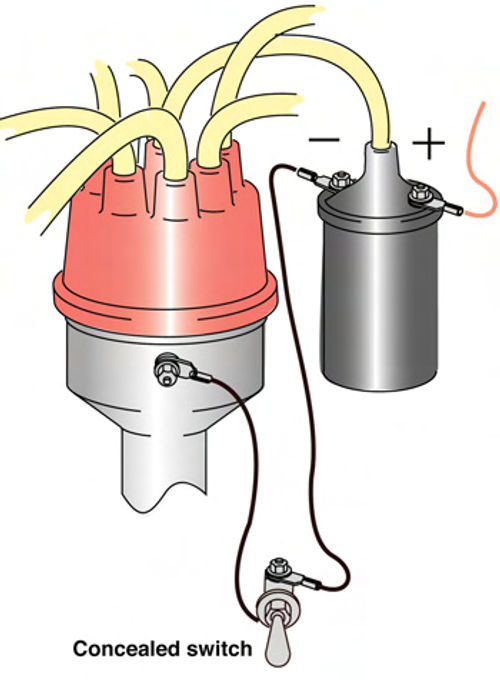
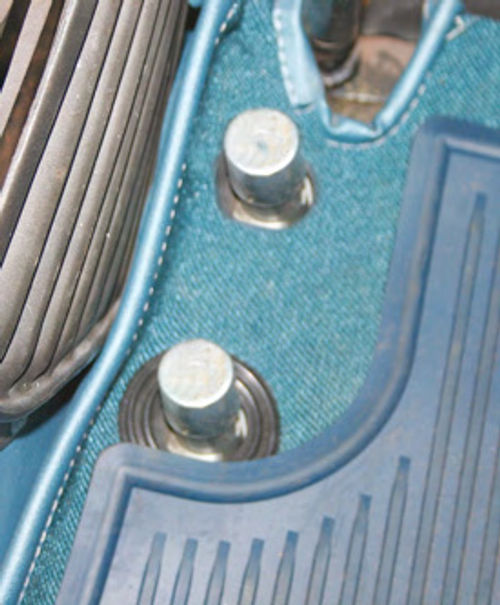
There are a couple of other matters to consider too in your defense against thievery. When you restore a car yourself over a period of years be mindful of how much value you are adding to the vehicle as you go.
For example, I have a 1955 Chevy Bel Air wagon, featured in the February issue of Auto Restorer, thatI paid $7000 for six years ago. Since then I have restored it mechanically, stripped and painted it, done the upholstery in the original fabrics and had all the chrome re-plated.
Today it is easily worth in the neighborhood of $25,000. If I had not updated my insurance and paid a little more in premiums as I went along, and the car were stolen today, I’d only be entitled to $7000. Sure the $25,000 wouldn’t bring back my restored ride, but it would make me feel a little better than $7000.
Another tip is to check the title of any car you plan to buy to make sure it really is the title for the car.
Do the numbers match? Is there any kind of lien against the car? And is the car still on the registration rolls in the state in which you purchased it? These things could be important. You wouldn’t want to inadvertently buy a stolen car and have to give it back when that fact is discovered.
Always Playing the Odds
All of these tips and suggestions will work most of the time and, in combination, you can certainly multiply your odds of thwarting a thief. But don’t count absolutely on any of them. If my son could (and still can) hop in almost any car and drive it away, less honorable people can too. Outthink a thief and protect your classic accordingly.
Incidentally, my son, who became a software engineer, says that any good hacker with a laptop and a little knowledge can download an electronic key for your contemporary car in just a few minutes and be on his way.
So keep up those car payments. The people who repossess cars for a living are not falling behind the curve.
















